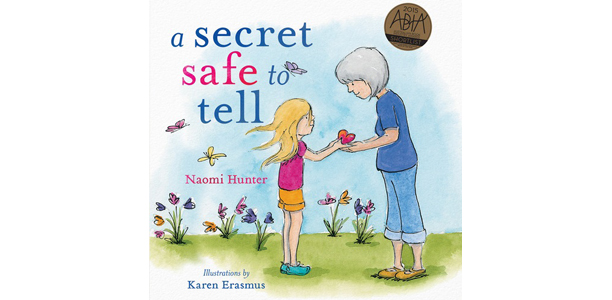Title
A Secret Safe to Tell
Description
It happened when I was little,
Always when we were alone.
… But sometimes he did things that worried me,
And made me feel completely strange on the inside.
I thought games were supposed to be FUN.
This is a gentle book that encourages children to tell someone about any confusing feelings that they might be experiencing as a way of healing.
Publishing information
Naomi Hunter (author), Karen Erasmus (illustrator), Adam Laszczuk (designer)
Published 2015 by Empowering Resources
ISBN
97800994501004 (paperback)
97800994501011 (hardback)
Themes / Keywords
Child abuse, Child sexual abuse, Child abuse – prevention, Child sexual abuse – prevention, Child molesters
Target audience
Primary school aged children
Benefits
| + | Simple, expressive language |
| + | Illustrations are visually appealing and fit well with the text on each page |
| + | Easy for children to understand |
| + | Clear message |
| + | Focuses on issues that are rarely touched on in literature for young children |
| + | May be a useful tool for discussing abuse with young children |
Limitations
- Primarily aimed at girls (female protagonist, images designed to appeal to girls)
- May be more appropriate to discuss one-on-one, rather than with a group of children
- Does not talk about “what happens next”
Educational outcomes (Australian Curriculum)
 Personal, social and community health
Personal, social and community health
Being healthy, safe and active
- Identifying people and behaviours that help themselves stay safe and healthy, and ways they can ask for help when they feel uncomfortable, unsafe or need help with a problem. Recognising physical responses that indicate they are feeling uncomfortable or unsafe. Applying strategies that can be used in situations that make them feel uncomfortable or unsafe. (Foundation – ACPPS003) (Years 1 and 2 – ACPPS017) (Years 3 and 4 – ACPPS035)
English
Language
- Understand that language can be used to explore ways of expressing needs, likes and dislikes. Recognising some of the ways we can use speech, gesture, writing and media to communicate feelings. Recognising some of the ways emotions and feelings can be conveyed and influenced by visual representations. (Foundation – ACELA1429) (Year 1 – ACELA1787, ACELA1444)
- Exploring in stories, everyday and media texts moral and social dilemmas; such as right and wrong, fairness/unfairness, inclusion and exclusion; learning to use language to describe actions and consider consequences. (Year 2 – ACELA1462)
- Identify visual representations of characters’ actions, reactions, speech and thought processes in narratives, and consider how these images add to or contradict or multiply the meaning of accompanying words. (Year 2 – ACELA1469)
- Identify the effect on audiences of techniques, for example shot size, vertical camera angle and layout. Noting how the relationship between characters can be depicted in illustrations through: the positioning of the characters; the distance between them; the relative size; one character looking up at the other (power relationships); facial expressions and body gesture. Observing how images construct a relationship with the viewer through such strategies as how close ups are more engaging than distanced images, which can suggest alienation or loneliness. (Year 3 – ACELA1483)
Literature
- Recognise that texts are created by authors who tell stories and share experiences. (Foundation – ACELT1575)
Literacy
- Use comprehension strategies to build literal and inferred meaning about key events, ideas and information. (Year 1 – ACELY1660)
- Identify the audience of imaginative, informative and persuasive texts. Identify the main purpose of a text. (Year 2 – ACELY1668) (Year 3 – ACELY1678)
- Identify the point of view in a text and suggest alternative points of view. (Year 3 – ACELY1675)











